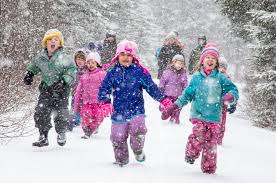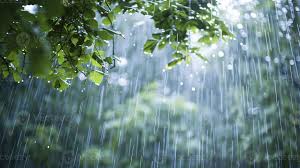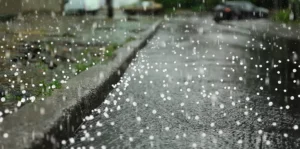STRAND 2: CYCLE Sub-strand 1: Earth Science
Content Standard: B7.2.1.1:
Recognise that the water cycle is an example of repeated patterns of change in nature and understand how it occurs.
Origin Of Earth Water.
Water is essential to life on Earth. It is one of the conditions that makes life possible on this planet (earth). Scientists have long debated whether the Earth’s water was here when the planet formed or whether it arrived later. A study suggests that water originated in rocks from which the Earth was built. Water is now everywhere on earth. That is, in the clouds, the oceans and rivers, even in our bodies. Earth water is always in movement and this natural process is known as water cycle or hydrological cycle.
Sources of Water
Sources of water include : Rain(precipitation) , underground water, surface water.
Rain Water: this refers liquid precipitations of condensed water vapour in the atmosphere.
Underground Water: this refers to water stored beneath the earth surface in various forms
Eg. Wells geysers, soil water etc
Surface water : this refers a body of water collected on the surface of the earth.
Eg. Ocean, rivers lakes etc
Indicator: B7.2.1.1.1:
Know how water cycle occurs as a repeated pattern in nature.
A cycle is an event that takes place regularly and repeatedly. Water cycleshows the continuous movement of water within the Earth and the atmosphere. It can be defined as the continuous movement of water from the earth’s surface to the atmosphere and then back to the ground (earth). Water is always changing states between solid, liquid and gas(vapour) with all these processes happening within a short period of time.
Stages of Water Cycle
A complete water cycle has four stages namely; evaporation, condensation, precipitation and collection.
Stage I: Evaporation. This is the initial stage of water cycle.
Definition: Evaporation is the process by which liquid water on the earth surface changes to vapour. evaporation is caused mainly by the heat from the sun and occurs on the surface water bodies and the soil. the water vapour is warm and less dense than air so it is able to rise to the upper atmosphere.
Stage II: Condensation.
Definition: Condensation is the process by which warm water vapour is converted to water droplets when it is cooled down in sky. The warm water vapour which rises into the atmosphere is cooled and converted into water droplets. The water droplets may be cooled further to form ice. A mixture of the water droplets, ice and water vapour suspended in the atmosphere is called cloud. A saturated mixture of air and water droplets (liquid – gas mixture) close the earth surface is called fog.
Stage III: Precipitation.
Definition: this is process where water held up in the clouds is released to the earth surface. Precipitation occurs when so much water has condensed that the air cannot hold it anymore. The clouds get heavy and water falls back to the earth with the help of gravity. Precipitation can happen in the form of rain, snow, hail or sleet.
 Snow
Snow
 Sleet
Sleet
 Rain
Rain
 Hail
Hail
Stage IV: Transpiration.
Definition: Transpiration is the process by which plants release water into the atmosphere in the form of water vapour through the stomata on their leaves.
Plants, with the aid of their roots absorb percolated water from the soil into their tissues and release it through transpiration in the form of water vapour.
The cycle starts all over with the same stages repeating in the same order. That is why it is called water cycle
Click the link below for video of water cycle.
Description Of The Water Cycle
The Sun which drives the water cycle heats water in the water bodies. Water evaporates water vapour into the air. When the water vapour rises, it starts cooling. The water vapour condenses causing the formation of droplets of water which then forms clouds. When these clouds become too heavy to float in the air, they fall under gravity due to their weight as rain/precipitation. The precipitated water is collected as surface water or percolates into the earth crust as ground water. This water is absorbed by plants and transpired back into the atmosphere.
The heat of the sun vaporizes liquid water in surface water sources and the cycle begins all over again.
What will happen if there were no water cycle?
disruption or absence of the water cycle will result in the following
If there were no water cycle, lakes, rivers, and underground water source would dry up. All freshwater resources would be negatively affected, and life on Earth would completely cease.
The lack of water would make it impossible to grow crops for food. The leaves of plants will fall because of lack of water in the soil. The plants will in the end die. The death of plants would mark the end of photosynthesis, halting the steady production of oxygen and consumption of excess atmospheric carbon dioxide.
No plant life would also mean the destruction of all food chains, as photosynthesizing plant form the nutritional backbone for vast majority of life. Carbon dioxide content in the atmosphere would continue to increase. Air would become less breathable, making it poisonous or harmful.
The increase in carbon dioxide would also magnify the greenhouse effect, causing the climate to change rapidly for the worse. More infrared radiation would be trapped in the atmosphere, temperature around the globe would continue to rise making life on earth unbearable.
Indicator(s): B7.2.1.1.2
Describe the importance of the water cycle in nature.
water cycle:
- provides clean water: Water cycle make freshwater available in a form of rain.
- keeps the amount of water on the earth’s surface constant:(Water removed from the earth during evaporation and transpiration condense and return to the earth in a form of rain and snow.)
- serves as carrier of nutrients: As water moves through and across the soil, it carries valuable nutrients for plant growth.
- Improves water table.
- Regulates the weather pattern.
Test Your Understanding
1. Explain how the water cycle is useful to:
a. life on planet earth b. crop production
2. Briefly describe the water cycle in your own words
3.Draw a flow chat to illustrate the water cycle
4. Explain why the water cycle is a repeated pattern.
5. Describe how clouds are formed.
About Instructor

